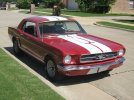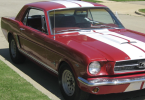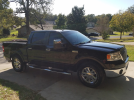SixPapaCharlie
May the force be with you
- Joined
- Aug 8, 2013
- Messages
- 16,024
- Display Name
Display name:
Sixer
I don't know how to professionally paint but I know how to amateur paint. I painted a pinewood derby car in cub scouts and once I read on the internet that you can mix rustoleum 50/50 with mineral spirits and use a fine roller to paint a car. I take risks so I painted this thing front to back in the most ghetto way possible for about $200:

I sprayed the stripes, rattle canned the clear and it was not amazing but it was really good looking. Point is I painted some sht once.
So today I am painting a part I bought for an airplane (Unless that isn't allowed, then it was a pinewood derby car for my kid)
I prime it, I thin out some enamal and airbrush the pinewood derby car and it looks great.
Then I go over it with clear (Krylon rattle can) and within a minute it looks like I poured acetone on it. All the paint bubbles, and peels off.
I grab a random piece of plastic from plastic storage and spray rattle can krylon paint on it, let it dry. Then I get a different can of krylon clear, spray it on and boon, bubbles and peels.
Last test, I spray a piece of plastic, let it dry and then SPRAY A SECOND COAT OF THE SAME PAINT. Bubbles and peels.
Has something in paint changed or am I missing something obvious. Why would adding a 2nd coat remove the first coat.
I have tried adding the 2nd coat after about 2 hours and I have tried after about 2 days. same result. the second round of spraying destroys the original.
Also, I sold that Mustang to pay for flying lessons.
I want that car back.

I sprayed the stripes, rattle canned the clear and it was not amazing but it was really good looking. Point is I painted some sht once.
So today I am painting a part I bought for an airplane (Unless that isn't allowed, then it was a pinewood derby car for my kid)
I prime it, I thin out some enamal and airbrush the pinewood derby car and it looks great.
Then I go over it with clear (Krylon rattle can) and within a minute it looks like I poured acetone on it. All the paint bubbles, and peels off.
I grab a random piece of plastic from plastic storage and spray rattle can krylon paint on it, let it dry. Then I get a different can of krylon clear, spray it on and boon, bubbles and peels.
Last test, I spray a piece of plastic, let it dry and then SPRAY A SECOND COAT OF THE SAME PAINT. Bubbles and peels.
Has something in paint changed or am I missing something obvious. Why would adding a 2nd coat remove the first coat.
I have tried adding the 2nd coat after about 2 hours and I have tried after about 2 days. same result. the second round of spraying destroys the original.
Also, I sold that Mustang to pay for flying lessons.
I want that car back.


